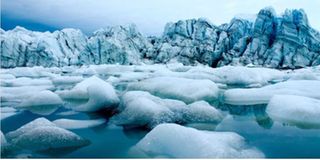Climate Fact Check: Earth losing Greenland ice sheet contrary to claim that it continues to grow at record levels

The Greenland ice sheet, which consists of layers of compressed snow from more than 100,000 years ago, is the largest ice body in the world after the Antarctic Ice sheet.
Research by European Geosciences Union scientists published on January 25, 2021 showed that earth lost 3.8 trillion tonnes of the Greenland ice sheet, contrary to a claim by a social media user that the ice sheet continues to grow at record levels.
The article shows that the loss was part of 28 trillion tonnes of ice that the earth lost between 1994 and 2017. Besides the Greenland ice, the 28 trillion tonnes comprise 7.6 trillion from the Arctic sea, 6.5 trillion from the Antarctic ice shelves, 6.1 trillion from mountain glaciers, 2.5 trillion from Antarctic ice sheet and 0.9 from Southern Ocean sea ice.
The research was established following satellite observations and numerical models that showed the earth has lost its ice at a rate of 57 per cent since the 1990s – from 0.8 trillion to 1.2 trillion tonnes per year, leading to a rise of sea levels by 34.6 milimetres
The Greenland ice sheet, which consists of layers of compressed snow from more than 100,000 years ago, is the largest ice body in the world after the Antarctic ice sheet, and has been adversely affected by climate change. Most of it is believed to melt in the likely near future unless global warming is reversed.
If the 3.8 trillion tonnes of ice were to melt, global sea levels would rise by an average of seven metres, possibly leading to the submerging of islands and coastlines.
This would affect African coastlines, threatening heritage sites with coastal flooding and erosion by 2050, Nature Climate Change explained.
“Sea levels have been rising at a faster rate over the past three decades compared with the twentieth century, a process that is expected to gather pace through the twenty-first century,” says Nature Climate Change.
“Together with changing weather patterns, this is expected to intensify coastal flooding and coastal erosion, exacerbating damages to coastal zone assets.”
North Africa, for example, has 23 heritage sites exposed, with West Africa second with 18. Southern Africa has seven exposed sites, with four in East Africa.
“Cultural sites, which tend to be either archaeological or historically built heritage, will be affected by both erosion and flooding, while bio-cultural and natural areas are more likely to recover from episodic flooding,” Nature Climate Change says.
“How much area a heritage site can lose to flooding and erosion and still maintain its value (for example, cultural, ecological, indigenous and economic) is a question of growing importance for all protected areas and World Heritage Sites, and demands site-specific local studies.
“The same applies to the capacity of natural coastal systems to adapt and absorb other external shocks, such as changes in salinity, which remains unknown.
“Anthropogenic modification of coastal processes will also affect natural systems’ responses to shoreline change.”
This fact check was produced by the Daily Nation with support from Code for Africa’s PesaCheck, the International Fact Checking Network, and the African





